I first heard the term ‘re-wilding’ at Glee 2017, the horticultural trades show. It’s one of the big new trends in gardening.
It means appreciating, re-introducing or conserving the wild plants, animals and bugs that live in your environment. Let nature take its course, and don’t be too controlling.
This week, I have read three completely different publications, each addressing a different aspect of re-wilding. So I will review all three, because together they show the different ways in which ‘re-wilding’ can enrich your life.
‘Re-wilding’ in your garden
When you hear the term ‘re-wilding’, do you think of swapping your lawn for a meadow, and sowing wild-flowers? That is, indeed, part of it.

Wild salsify in an urban garden – we’re now growing a wider range of wildflowers in our gardens.
But Val Bourne gives it a wider context in her new book, The Living Jigsaw’ (how to create a healthy garden ecology) which I have just been sent for review. (Note: links to Amazon are affiliate links, which means I may get a small fee if you buy through them, but it won’t affect the price you pay.)
Val describes her re-wilding ‘damascene moment’. When she explained what aphids were to her nieces, she also explained how the ants farmed the aphids, how ladybirds ate the aphids, and how baby birds need to be fed with thousands of tiny insects. ‘All these creatures fit together like a living jigsaw,’ she says. ‘They all need each other in order to survive.’
The Living Jigsaw is about gardening without segregating ‘insects and pests into “saints and sinners” – look at them as part of a self-limiting food chain.’
She goes on to talk about the insect life and bird life in your garden, and how to deal with slugs and snails without using pellets. She particularly warns against slug pellets containing metaldehyde.
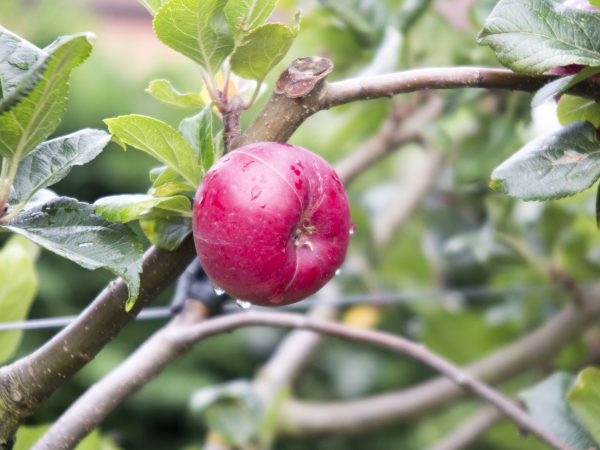
Apple trees are in Val Bourne’s top 100 plants for an eco-friendly garden.
At the end, there is list a Top 100 Plants for an Eco-Friendly Garden. I checked how many of them I have in this garden. We have around 50 of the 100. I could do better, as I like to support wildlife.
‘Re-wilding’ on holiday
Plant-lovers say that nothing teaches you more about how to grow plants than seeing them growing wild in their native countries. Many keen plantaholics choose their holiday destinations specifically for that purpose.
When I interviewed Gill and Peter Regan for The English Garden magazine, Gill told me that they’d struggled to keep peonies alive until she took a photograph of a peony growing under a tree in Iran. ‘I realised that our peony roots were probably rotting due to the damp in our garden.’ The Regans gained similar insights from trips to see Sternbergias in Turkey, bergenias in Yunnan, and plants growing wild in China, Western Australia, Peru and more.
Connect with plants in their natural habitat
I visited my brother, Hugo and his wife, Anna, in El Canuelo, a small village in Andalucia. Although I wrote about crazily wonderful gardening ideas, I didn’t think about the wild flowers.
I’ve just been sent Tony Hall’s Wild Plants of Southern Spain (Kew Publishing) to review. It’s a botanical book with clear, close-up photographs, botanical names and even a small printed ‘ruler’ on the back cover flap. ‘Take photographs of the plants you want to identify’ advises Tony (rather than pulling them up or cutting the flowers).

I’ll enjoy walking around the village and hillside near El Canuelo in Andalucia even more if I learn to spot the wild plants.
I plan to give this book to Anna and Hugo, because El Canuelo is on a fairly wild hillside. Hugo frequently goes for long walks in the countryside, as do their many guests. I feel that taking this book and identifying the wild flowers of the region is part of today’s mindfulness trend. Knowing what the plants are helps to give a sense of place. Also, as a gardener, I can learn from seeing how and where wild plants grow.
‘Re-wilding’ in the city
I recently went to a pop-up gallery in Floral St, London WC2 for an evening run by Rakes Progress and Women In Journalism. Rakes Progress is one of the new breed of independent magazines, which are proving that ‘print is not dead.’
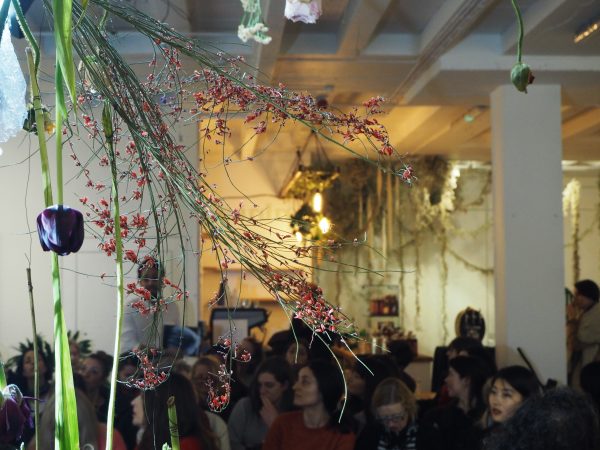
Women in Journalism seminar and hanging flower installation at Rakes Progress pop-up shop in Floral St, Covent Garden.
Somewhat appropriately, the Rakes Progress exhibition was called ‘Dead Beautiful’. The art and ‘floral installation’ showcased the beauty of dead and dying flowers. Swathes of flowers and greenery – some living, some dying, some dried -hung from the ceilings, along with branches.
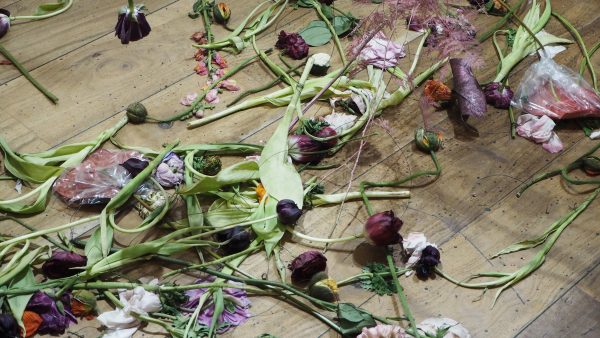
And there was a swirl of petals on the floor around even apparently conventional flower arrangements. My mother would have taken a broom to it all.

Almost ‘traditional’ flower arrangement at Rakes Progress, except that the fallen petals and dying flower are part of it, and there are more on the floor around the pedestal.
So why is this ‘re-wilding’? Well, when someone goes into a gallery like this and thinks ‘that plant looks amazing,’ it often triggers an interest in more plants that look amazing. An imaginative display (or floral installation as I think we must call it now) can lead to people buying plants for their home, balcony, courtyard or window-sill. From there, they may start to visit gardens and appreciate the impact of public parks on the environment and health.
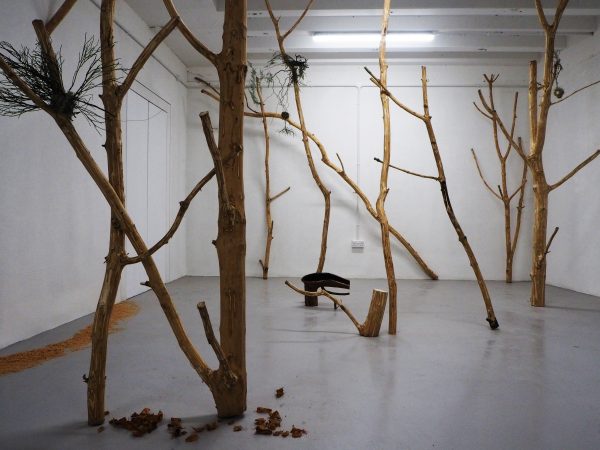
A forest in the city? Well, a floral installation to remind city dwellers of real wood and forests….including fallen leaves and bark, and a swathe of sawdust where the trees have been cut down. That’s my interpretation anyway.
What individuals do and say matters. Urban front gardens have been concreted over in their thousands to create parking spaces. But once the owners of those houses start to appreciate the beauty of plants, they are more likely to try to create at least some greenery amongst the concrete. Fashionable floral installations can get people thinking differently about plants, because they demand that you stop and stare. If only to mutter that the floor needs a good sweep.
Re-wilding taps into the cycle of life
It’s that return to the appreciation of natural materials, traditional ways and the cycle of life that makes a magazine like Rakes Progress part of ‘re-wilding’. In my view, anyway, although Tom Loxley, co-founder of Rake’s Progress, also aligns it with the ‘slow living’ movement.
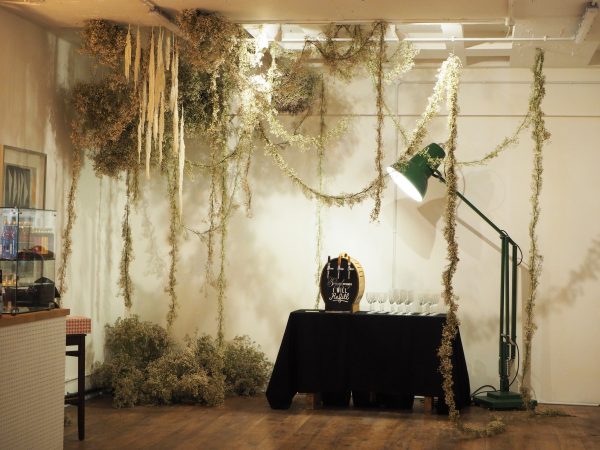
‘Re-wilding’ the London bar scene with hanging drapes of plants? In fact, this has definite echoes of the way Faversham decorates its town in the traditional hop festival….
Flip through the pages of issue 6 of Rakes Progress in this video, where I review it. It is gardening made hip, with gorgeous, brooding photography, interviews with ‘floral artists’, garden designers, craftsmen and more. There’s no advertising and no date on the issue. These magazines aim to be as timeless as books. However, unlike in coffee-table books, the writing is important, too. There are long, detailed articles, which will take you a while to read.
I’ll also be reviewing Val Bourne’s The Living Jigsaw and Tony Hall’s Wild Plants of Southern Spain in more depth on the Middlesized Garden YouTube channel.
If you’re interested in why ‘print is not dead’, by the way, we discussed how magazines are changing in response to the changing tastes of people today, especially Millenials.
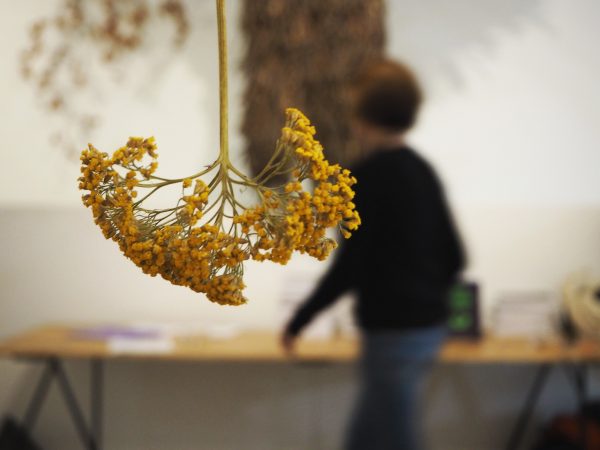
Wildflowers hanging upside down from the ceiling in a floral installation by the Urban Flower Company at the Rakes Progress popup shop.
Gardening writer, Alice Vincent, herself a Millenial, said that her generation don’t want to hear about shopping. ‘We either rent or have very small flats, so we’re more interested in experiences or something we can talk about.’ She also thought that the fashion for gardening amongst the young is a trend that will stick around. ‘Clean eating was a fad, and is now considered to be “over”, but it drove the current growth in veganism.’

Garden tools as part of the Rakes Progress art installation. I love it – this is an idea that would translate well into a home. If you don’t have space for a garden shed, hang your tools on the wall and appreciate their beauty. I particularly like that these are not all vintage tools – there are brand new ones there too.
So why does re-wilding matter to you?
Scientific tests have proved that slowing down to enjoy all your senses and ‘mindfulness’, helps stress, concentration and sleep. But to take it back to Val Bourne’s book – we are all part of the living jigsaw. We need bees and pollinating insects, and they need flowers and plants. At some point in the chain, even the less attractive bugs and beings play their part.
We don’t necessarily know how much each species contributes to the jigsaw. And we certainly can’t foretell the consequences of one or more disappearing from the earth. Even when re-wilding is a token activity – in an art installation, for example – it still has a message for us all. Let me know what you think, either in the comments below or on Facebook or Twitter.
Pin for reference:
The post What is ‘re-wilding’ and why does it matter to you? appeared first on The Middle-Sized Garden.
from The Middle-Sized Garden http://www.themiddlesizedgarden.co.uk/re-wilding-matter/

No comments:
Post a Comment